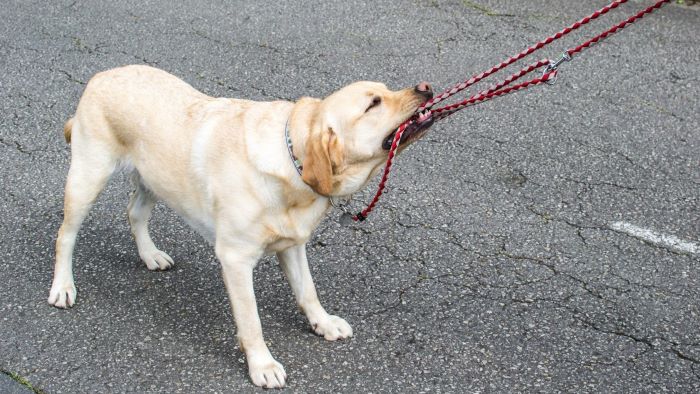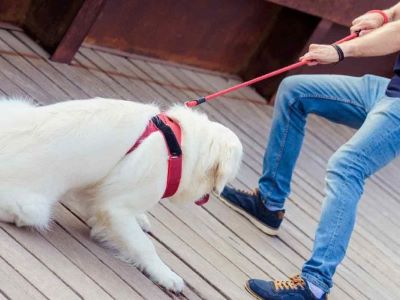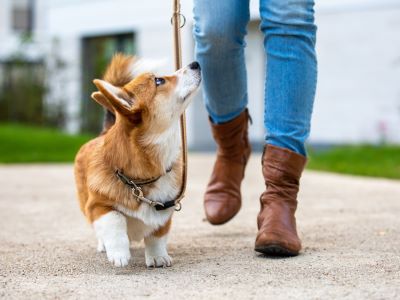Leashing up your dog for their daily walk should be a breeze – they’re supposed to jump for joy when they see the leash come out! But many dog owners encounter their pets, who dig in their heels and refuse to walk, even for owners who provide them with plenty of exercise. So, “Why does my dog not want to walk?“
In this article, we’ll explore the common reasons dogs refuse walks, advice for motivating reluctant pups, when you may need to seek professional help, and how to collaborate with your vet or trainer to identify mobility issues. There are many perplexing reasons why your dog may not walk even when they desperately need the exercise.

Common Reasons Dogs Refuse Walks

For many dogs, the daily walk around the neighbourhood is the highlight of their day. However, some pups aren’t always so eager to get moving when the leash comes out. There are many possible reasons why your dog doesn’t want to talk.[1]
Health Issues
Just like humans, dogs can experience pain or discomfort from medical conditions that make exercise uncomfortable. Some common examples include:
Arthritis – Joint inflammation and stiffness, especially in older dogs
Hip or elbow dysplasia – Malformed joints that cause lameness and arthritis
Paw injuries – Cuts, torn nails, or foot pad damage
Obesity – Excess weight puts strain on joints and lungs
If your dog is limping, crying out in pain during walks, or showing other signs of injury or soreness, a vet is needed to diagnose and treat the underlying problem.
Fear or Anxiety
Dogs who are fearful or anxious on walks will likely plant themselves and resist moving forward. Triggers can include:

- Loud noise like traffic, construction, or crowds
- New places outside the comfort of home
- Traumatic experiences like being attacked on a walk
Shaking, cowering, barking, and trying to hide are signs your dog is feeling frightened about something on your route.
Boredom
Does your daily walk feel repetitive and uninteresting to your dog? The same old neighbouring, pace, and route daily can lead to boredom. Dogs who don’t get mental stimulation from their walks may be less inclined to go.
Stubbornness or Laziness
Some dogs, especially independent-minded ones like terriers, may simply decide not to walk today. Pups who get ample playtime and exercise may claim occasional “mental health days” and just want to lounge around.
Weather Discomfort
Dogs can get overheated in summer just like people. And chilly air may be unappealing to small or thin-coated dogs in winter. Pay attention to your dog’s comfort level when temperatures are very high or low.
Needs More Overall Exercise
A young, energetic dog or one with demanding breeds in their heritage needs a lot more activity than a daily walk provides. Until they get a good workout running, swimming, or playing, they may not want to bother with pedestrian neighbourhood walks.
Investigating the Cause

When your dog starts refusing to walk, take time to observe their behaviour closely to determine what’s at the root of it. Here are some investigative tips:
Watch for signs of pain or lameness – Does your dog cry out, limp, or seem stiff or slow when they move? Arthritis and injuries often cause obvious pain.
Rule out medical issues with a vet visit – Your veterinarian can check for injuries, arthritis, hip dysplasia, and other problems that may limit mobility.
Note specific triggers for anxious behaviour – What seems to set your dog off during walks – certain sights, sounds, passing dogs? Pinpointing the cause of fear and anxiety can help you manage it.
Change locations and walk times – Does your dog walk better at quiet times of day or in different areas? This can help determine if boredom with the route is an issue.
Try motivators like treats or toys – Does waving a tasty treat encourage your pup to walk further? Use rewards to see if your dog is just being stubborn or lazy.
Look for overall signs of lethargy – Dogs who refuse walks but also sleep more, play less, and have no energy may need more exercise or have depression.
Encouraging Your Dog to Walk

Once you determine the likely cause for your dog refusing walks, you can take steps to get them moving again.
- Make it fun! Take new trails, let them sniff and explore, bring toys and treats, jog or play. A bored dog needs more adventure and variety.
- Keep walks short and go at their pace if your dog has mobility issues or anxiety. Let them stop and rest. Don’t force them to overexert themselves.
- Use reward systems with food, toys, or praise. Motivate reluctant dogs with whatever they respond to best.
- Consider a dog backpack to turn walks into satisfying “work” by letting your dog carry light loads.
- Schedule extra playtime or training activities to supplement boring walks with mental and physical stimulation.
- Try calming aids like pheromone collars or sprays for anxious dogs. Soothing medicine can reduce fearful behaviour.
- Get your dog moving and strengthen muscles with swimming, joint supplements, or mobility aids if health problems are slowing them down.
When to Seek Help
It’s often possible to get your dog walking happily again with lifestyle changes and home solutions. But in some cases, professional assistance is the best option:
- If your dog exhibits troubling symptoms like severe liming, crying in pain, loss of appetite, lethargy, or other troubling signs, promptly consult your vet.
- If anxiety is extreme and negatively impacting quality of life, your dog may need anti-anxiety medication or a specialized counterconditioning program. Seek help from your vet or animal behaviourist.
- If lack of exercise causes significant weight gain or joint problems, your dog may need intensive mobility support. Vet care, dog trainers, and specialist rehab can help manage obesity.
- If your dog still refuses to walk after trying solutions, a trainer can observe your walks and provide an outside perspective on additional changes needed.
- If your dog needs more activity than you can provide, consider hiring dog walkers or enrolling them in doggy daycare for active playdays.
Working with Your Veterinarian or Trainer
To get anxious or hurting dogs moving again, work closely with your veterinarian and/or professional dog trainer or behaviourist. Here are some of the ways they can help:
- Diagnose and prescribe medication for treating pain, arthritis, injuries, anxiety, and other medical issues making walks difficult.
- Custom-design a care & conditioning program to gradually expose anxious dogs to triggers like loud noises and help them overcome their fear.
- Fit your dog with booties, mobility harnesses, or cards to improve comfort and support for arthritic joints.
- Observe your dog’s walking behaviour and body language in challenging situations and make training recommendations.
- Consider prescribing calming supplements or anti-anxiety medications to help fearful dogs stay relaxed.
- Suggest doggy daycares, group play, or dog walkers to ensure your dog gets sufficient activity if you cannot meet their needs.
If health or behaviour problems make walking unrewarding for your pup, don’t try to strong-arm them into it. Working compassionately with the right professionals will help identify issues and find the motivation your dog needs to happily hit the road again. Patience, creativity, and medical care go a long way in encouraging reluctant dogs to walk.
FAQs
Why does my dog not want to walk?
Pain from arthritis or muscle weakness is a common reason why older dogs have trouble with walks. Have your vet examine your dog to determine if medical issues are making movement difficult. Supplements, mobility aids, or medication may help your senior dog stay active comfortably.
My dog only wants to walk for 5-10 minutes before lying down and refusing to move. What should I do?
Your dog may not have the stamina for long walks. Try keeping walks very short but more frequent. Also have your vet check for conditions like heart disease, arthritis, and hip dysplasia which could limit your dog’s endurance.
What can I do if my dog is afraid of the sights and sounds on our walks?
Anxiety triggers can make a dog refuse to walk. Try a silent harness and pheromone collar to keep them calm. Start walks in quiet areas and use treats to positively associate any scary encounter. Seek help from a trainer or behaviourist for severe fear.
Why does my dog sit down or pull on the leash when we’re out walking?
Resistance behaviours on a leash can indicate boredom with the route, distraction by smells or sights, or fear. Switch up where you walk, let your dog sniff and explore more, and motivate with treats. If pulling is extreme, a harness and training can help.
I can’t seem to get my puppy enthusiastic about our daily walks. What am I doing wrong?
Puppies have short attention spans and a lot of energy. Keep walks very short but active – let your puppy wander and play. Bring treats and toys to make the walk fun rather than just exercise. As your puppy ages, it will have more endurance and focus.
Conclusion
The daily neighbourhood stroll with your dog should be an enjoyable bonding experience and a healthy activity for you both. When your pup starts planting refusing to walk, don’t just drag them along. Take time to determine the root causes, whether it’s pain, fear, boredom, or lack of exercise. Address any medical issues with your vet’s help.
Make changes to your walking routine and style to motivate your dog. Consider professional training if anxiety or behaviour problems are at play. While it takes some detective work and patience to get your dog moving again, the right mix of medical care, training, and creative motivation can have them happily walking by your side once more.
Reference:
- Why Does My Puppy Refuse to Go on Walks? | AKC



